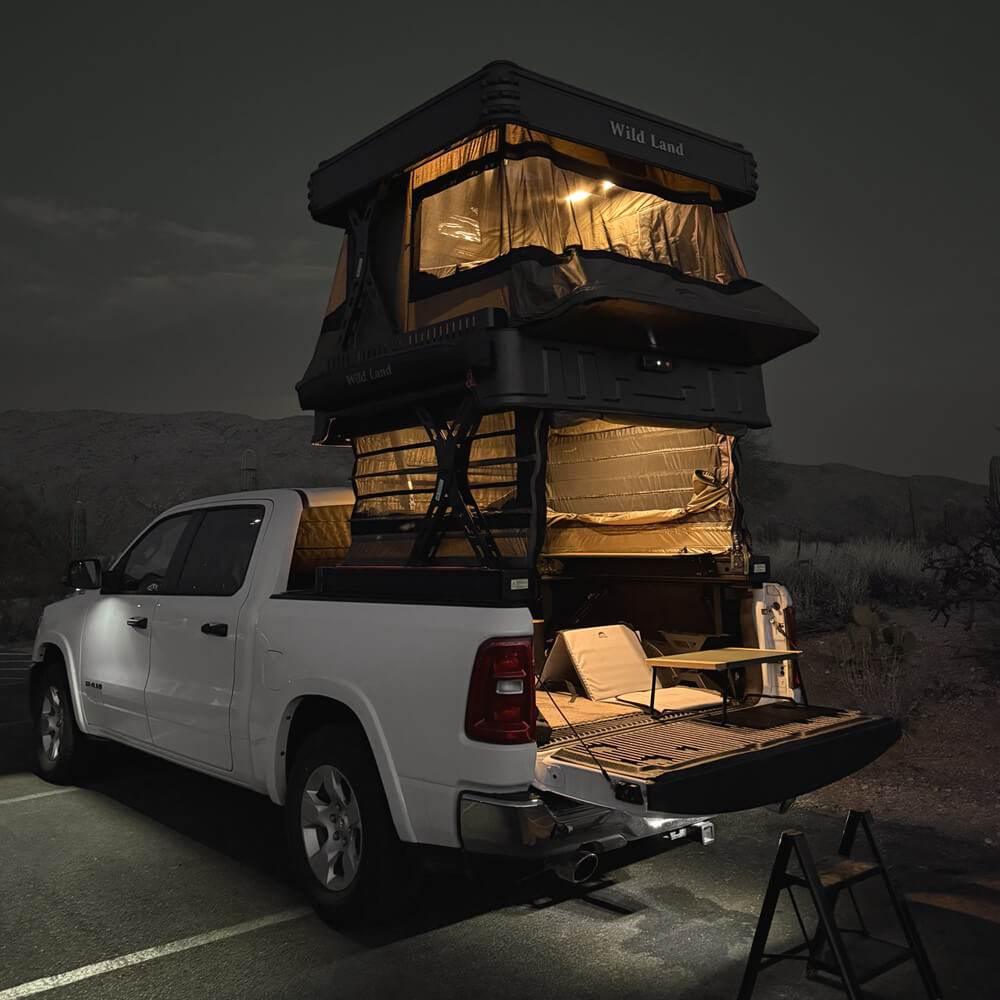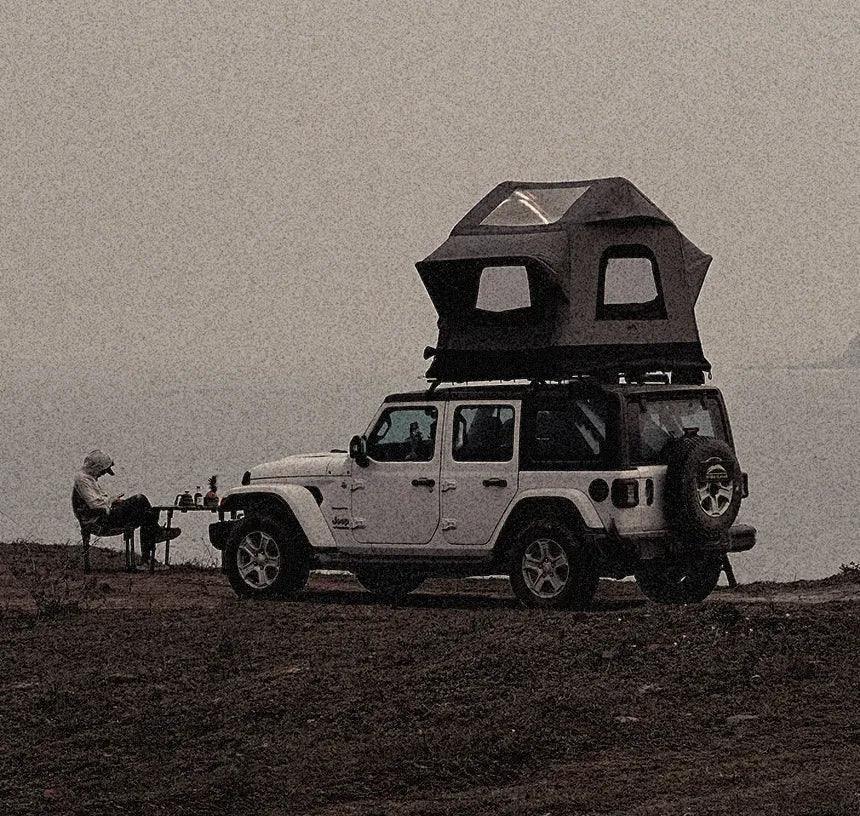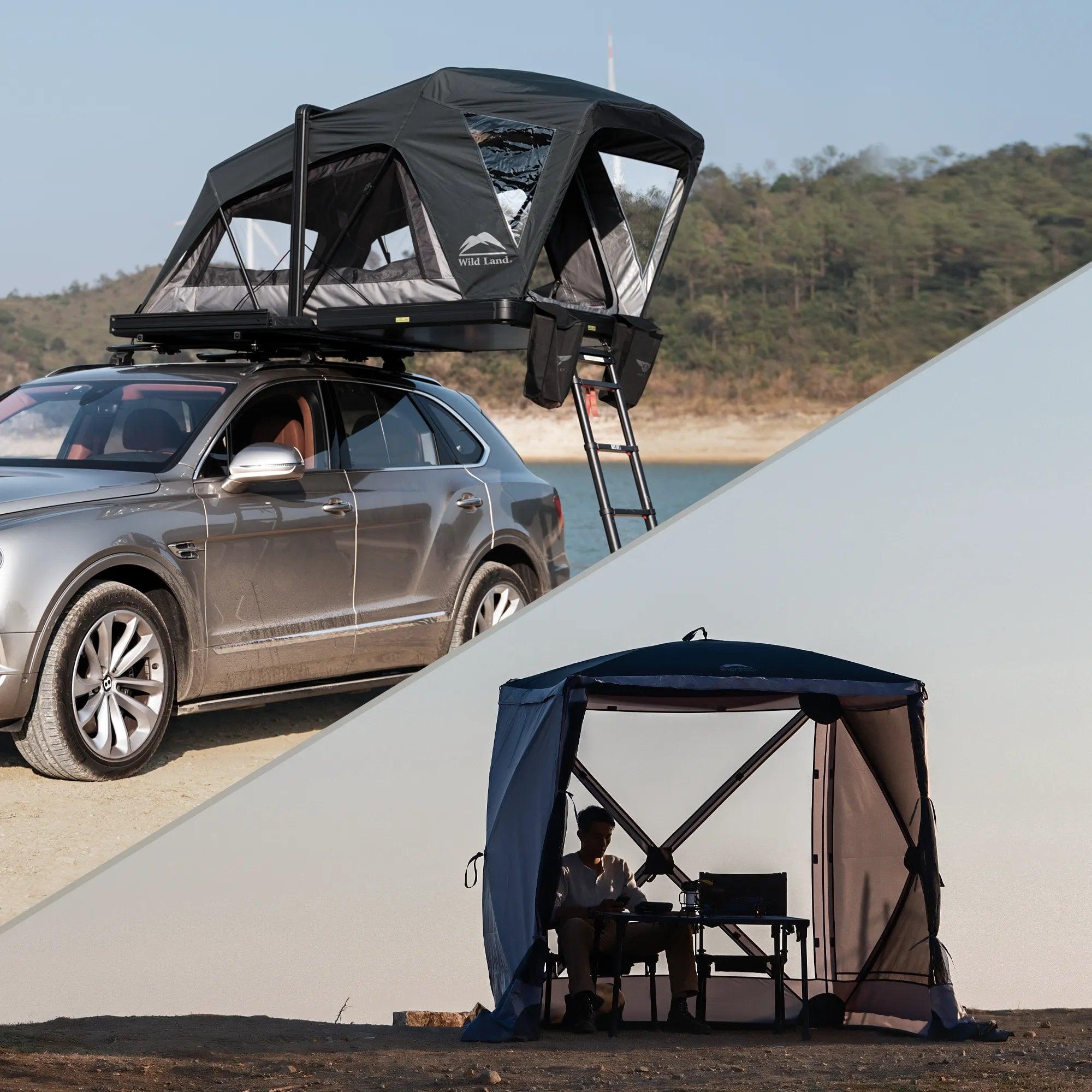Imagine transforming your vehicle into a mobile bedroom with a rooftop tent. A rooftop tent is a tent erected on the roof of your car, SUV or truck. It provides an elevated, comfortable sleeping platform that stays attached to your vehicle. Outdoor and overland enthusiasts have embraced rooftop tents as a game-changing camping gear. Because the tent folds out from the roof, you can camp wherever you park – no more crawling over rocky or wet ground. This convenience makes rooftop tents especially popular with 4×4 drivers, road-trippers, families and anyone who loves spontaneous outdoor adventures.
Wild Land Rooftop Tents: Key Advantages and Innovations
Wild Land is a brand focused on innovative car camping solutions. Wild Land advertises that they “redefine rooftop tents with innovative clamshell and soft shell designs for quick setup, superior wind stability, and spacious sleeping areas”. In practical terms, Wild Land tents use patented gas-strut mechanisms to pop open hardshell models in under a minute. The hardshell roofs are made of strong aluminum honeycomb panels and the tent fabrics are heavy-duty poly-oxford (e.g. 600D with 3000–3500mm PU coating), making the tents fully waterproof, UV-resistant and ready for four-season use. Inside the tent you’ll find comfort features like a 10cm self-inflating mattress and a 3D anti-condensation foam pad. Wild Land also includes built-in LED lighting on some models and provides large panoramic windows and vents so you can enjoy fresh air and sky views. In short, Wild Land tents combine smart engineering with user-friendly comfort, turning your rooftop camp into a cozy, high-tech shelter.
Key Features of Wild Land Tents:
- Quick Setup: Patented gas struts allow the hardshell models to pop open in seconds, so one person can have the tent ready in under a minute.
- Rugged, Weatherproof Build: The shells use aluminum honeycomb panels and heavy 600D Oxford fabrics. These materials are waterproof and UV-resistant (with PU ratings up to 3500mm), making the tent durable in rain, sun, and snow.
- Built-in Comfort: Every tent includes a 10cm self-inflating air mattress and anti-condensation pad for a cozy sleep. Some models even include LED strip lighting and a table/lounge kit for added convenience.
- Panoramic Design: Large windows and a mesh vent in the roof provide 360° views and airflow. You can stargaze through the skylight or open the vents for a cool breeze.
- Universal Fit: Wild Land tents are designed to mount on almost any SUV, 4×4, pickup, van or even trailers with roof racks, so you can take them on many kinds of vehicles.
Key Considerations When Choosing a Rooftop Tent
Before buying, think about how and where you'll camp and which features matter to you. Below are some key factors:- Size & Sleeping Capacity: Consider how many people will use the tent. As a rule of thumb, most 2-person RTTs are about 1.4 meters wide (allowing ~70cm per person). If you plan to camp with a child or pet, you may want extra width or length. Also check the tent’s packed dimensions to ensure it fits your roof rack.
- Weight & Vehicle Compatibility: Check your vehicle’s roof load ratings (static and dynamic) and roof rack capacity. A typical hard-shell tent weighs 40–80 kg. Make sure your car and crossbars can safely support the loaded tent and occupants. Use sturdy roof racks rated for at least 100 kg if possible.
- Hard Shell vs Soft Shell: Hard-shell tents have rigid roofs and unfold quickly (often with gas struts). They are more aerodynamic, tend to be quieter in wind, and often provide storage space for bedding when closed. Many hard-shell tents are true 4-season designs with solid floors, making them better in extreme weather. Soft-shell tents use fabric walls that fold out, giving more living space (they can extend beyond the vehicle width). Soft-shells are usually lighter and cheaper, but they generally have less insulation and no hard floor. Choose hard or soft based on your needs: e.g. families or winter campers might prefer hard-shell; budget travelers might like soft-shell.
- Waterproofing and Materials: Look at the fabric ratings. Good RTTs use high-density Oxford or polycotton fabric with PU waterproof coatings. For example, Wild Land tents have flysheet rated at 3000mm PU and floor at 3500mm PU, which resists heavy rain. Check also for sealed seams and a waterproof cover on the closed tent.
- Seasonal Use: If you camp in winter or cold climates, choose a true 4-season tent. Look for thicker fabrics and solid floor insulation. Heavy-duty materials will block wind and snow better. Also consider how well the tent ventilates: mesh windows and vents will help reduce condensation in summer.
- Accessories and Extras: Some tents come with annexes, awnings, or extras like built-in mattresses and lights. Decide if you need an annex room for gear or shade. Wild Land offers compatible annexes and cargo racks to expand living space. Also consider ease of storage: hard-shell models often allow you to leave bedding inside when closed (soft-shells usually do not).
Tips for First-Time Rooftop Tent Users
- Practice Setup: Before heading far from home, unpack and try setting up your new tent in the backyard. This helps you learn the mechanism (and that all parts are included) so you won’t be fumbling with it for the first time in a rainstorm.
- Park Level: Always park on as level ground as possible. A tilted car will make the tent lopsided and can be unsafe. Level ground also lets the mattresses and occupants stay flat. Avoid hills or soft ground under the wheels.
- Check Weight Limits: Confirm that the tent’s weight (plus occupants) does not exceed your car’s roof load rating. When climbing up or down, also be careful to keep your weight distributed evenly.
- Secure the Ladder: When the tent is up, make sure the ladder is fully extended and locked. Test it carefully before climbing. Never lean the ladder on soft ground or slick surfaces—use the adjustment foot to level it.
- Ventilate and Stay Dry: Use the mesh panels and vents to allow airflow. Good ventilation reduces condensation inside. Close windows and vents quickly if rain starts. Keep the tent clean and dry when closing it to prevent mold.
- Leave Bedding in Hard-Shells: If you have a hard-shell tent, you can often leave pillows and blankets inside when you fold it shut. This means you can wake up and drive off without re-making the bed. (Most soft-shell tents do not allow this.)
- Never Use Open Heaters: Do not use any combustion heaters or cooking stoves inside the tent. It’s better to layer up with a good sleeping bag for warmth. Burning fuel in an enclosed tent is a fire and carbon-monoxide hazard.
- Plan for Weather: Check the forecast and avoid camping in very high winds or lightning. If a storm comes, make sure the tent cover is latched securely and use the ground straps or annex to brace it if needed.
By keeping these tips in mind and choosing the right Wild Land rooftop tent for your needs, you’ll be well-prepared to enjoy comfortable, elevated camping wherever the road (or trail) takes you.
Sources: Expert guides and manufacturers’ specifications have been used to provide the most current informationSources: Expert guides and manufacturers’ specifications have been used to provide the most current information (including Wild Land official website)





Leave a comment
All comments are moderated before being published.
This site is protected by hCaptcha and the hCaptcha Privacy Policy and Terms of Service apply.